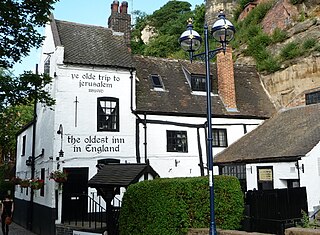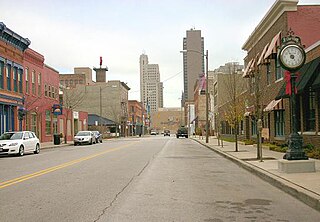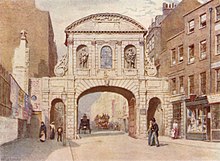
A pub is a drinking establishment licensed to serve alcoholic drinks for consumption on the premises. The term first appeared in the late 17th century, to differentiate private houses from those open to the public as alehouses, taverns and inns. Today, there is no strict definition, but CAMRA states a pub has four characteristics:
- is open to the public without membership or residency
- serves draught beer or cider without requiring food be consumed
- has at least one indoor area not laid out for meals
- allows drinks to be bought at a bar

Ye Olde Cheshire Cheese is a Grade II listed public house at 145 Fleet Street, on Wine Office Court, City of London. Rebuilt shortly after the Great Fire of 1666, the pub is known for its literary associations, with its regular patrons having included Charles Dickens, G. K. Chesterton and Mark Twain.

The Society of Cogers is a free speech society, established in 1755 in the City of London. It is the oldest debating society in the world and one of the oldest speaking gatherings of any kind.

Ye Olde Fighting Cocks is a public house in St Albans, Hertfordshire, England. It is one of several pubs that lay claim to being the oldest in England, claiming to have been in business since 793 AD. The pub was once recognized as the oldest in England by the Guinness World Records, but this title was wrested in 2000. The building is described by Historic England as being of 16th-century appearance, but as the earliest date for which it can be proved to have been licensed is 1756, and even that date is not certain, its claim to this record is somewhat uncertain. Others such as the Ye Olde Man & Scythe in Bolton, Greater Manchester, and Ye Olde Trip to Jerusalem in Nottingham may have better claims. Even in St Albans, the White Hart and the Fleur de Lys are believed to have been trading as inns in the late medieval period.

Ye Olde Trip to Jerusalem is a Grade II listed public house in Nottingham which claims to have been established in 1189, although there is no documentation to verify this date. The building rests against Castle Rock, upon which Nottingham Castle is built, and is attached to several caves, carved out of the soft sandstone. These were reputedly originally used as a brewhouse for the castle, dating from the medieval period.

Verulamium Park is a park in St Albans, Hertfordshire. Set in over 100 acres (0.40 km2) of parkland, Verulamium Park was purchased from the Earl of Verulam in 1929 by the then City Corporation. Today the park is owned and operated by St Albans City and District Council.

Ye Olde Man & Scythe is a public house on Churchgate in Bolton, England. The earliest recorded mention of its name is in a charter from 1251, making it one of the ten oldest public houses in Britain and the oldest in Bolton. The present form of the name, prefixed with "Ye Olde", is a pseudoarchaism derived from the Man and Scythe Inn; it derives from the crest of the Pilkington family, which consists of a reaper using a scythe, alluding to a tradition about one of the early members of the family.
The Fortune of War was a pub in Smithfield, London, on the junction of Giltspur Street and Cock Lane. The location, originally known as 'Pie Corner', is where a statue of the Golden Boy of Pye Corner marks the place where the Great Fire of London stopped. The statue was initially built in the front of the pub.

The Warehouse District in central Toledo, Ohio, United States has seen an upturn with new residential and entertainment developments alongside many in-use warehouses and warehouses that are in the process of being renovated. The district has been the epicenter of recent revitalization efforts of downtown Toledo. A wide variety of bars and restaurants can be found in this district. Hensville is a pedestrian mall that is located directly behind the Fifth Third Field and is a hub of live entertainment. The Warehouse District is immediately south of Downtown and is roughly bordered by Swan Creek, Monroe Street, Ontario Street, the Anthony Wayne Trail and I-75.

The Cock is a Grade II listed public house at 360 North End Road, Fulham, London.

The Ye Olde Mitre is a Grade II listed public house at 1 Ely Court, Ely Place, Holborn, London EC1N 6SJ.

The Trafalgar Tavern is a Grade II listed public house at Park Row, Greenwich, London, situated on the south bank of the River Thames, east of and adjacent to the Old Royal Naval College.

The Mitre Inn is a public house at 58 High Street, Chipping Barnet, London. It was established by 1633 and is probably the oldest remaining of the town's once numerous coaching inns. It is a grade II listed building with Historic England and is currently styled "Ye Olde Mitre Inne".

Ye Olde Cherry Tree is a grade II listed public house on the corner of The Green and The Mall in Southgate, north London, which dates from around 1695.

The Queen's Head Tavern was located on Fleet Street to the east of the Temple Bar in London. It was already established in 1682 when it is mentioned in the diary of Narcissus Luttrell: "The 2nd, in the morning early, a fire broke out in the back part of the Queen's Head Tavern, by Temple Bar".

Old Doctor Butler's Head is a pub in Mason's Avenue, London EC2. The pub was named after the physician William Butler, a doctor at the court of James I. Butler is credited with inventing the medicinal drink Dr Butler’s purging ale, which became popular in 17th-century England.

The Old Bell is a pub at 95 Fleet Street, London EC4.

Chalton Street is a street in the Somers Town neighbourhood of London, England. Chalton Street is over a kilometre long and stretches from Euston Road to almost Camden Town, before taking a hard right turn and terminating at St Pancras Hospital.






















